Down To Earth(June1-15 2023)
Nano Urea
-
India has become the first country to have developed and rolled out nano-fertilisers. The Indian Farmers Fertiliser Cooperative Limited (IFFCO) which has patented Nono-Urea and Nano-DAP claims that Nano-urea and Nano-dap have several advantages over their conventional granular counterparts.
What are Nano Fertilisers?
- Nano fertilisers are synthesised or modified forms of traditional fertilisers with the help of nanotechnology used to improve soil fertility, productivity and quality of agricultural products.
- Nano Urea: Nano Urea liquid contains 4% Nitrogen as encapsulated nitrogen analogues (analogue is a compound having a structure similar to that of another compound, but differing from it in respect to a certain component). It has a small size (20-50 nm) and covers more surface area and number of particles per unit area than conventional Urea. It is an essential component of 4R nutrient stewardship. It is also absorbed directly by plants leaves.
- Nano DAP (Diammonium phosphate): Developed by IFFCO it provides nitrogen and phosphorus to plants.Nano DAP (Liquid) has particle size less than 100 Nanometre (nm) which enables it to enter easily inside the seed surface or through stomata and other plant openings. A notable property of DAP is the alkaline pH. DAP also acts as a fire retardant. For example, a mixture of DAP and other ingredients can be spread in advance of a fire to prevent a forest from burning. DAP has chemical formula (NH4)2(HPO4) is one of a series of water-soluble ammonium phosphate salts.
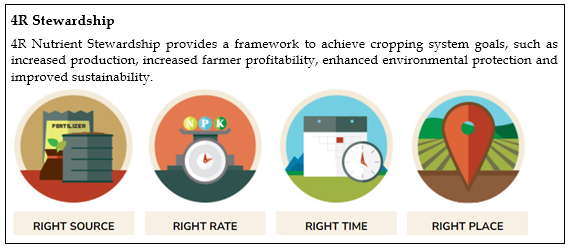
Advantages of Nano Fertilizers:
- Nano fertilizers cost less than subsidised conventional fertilizers.
- Eg: A 500 ml bottle of nano urea (Rs 240) can replace a 45 kg bag of conventional urea
(Rs 267). - Nano urea can reduce transportation and warehousing costs, and result in better crop productivity and higher income for farmers.
- It can reduce the import bills on fertiliser production and at the same time reduce environmental pollution and farm input costs.
- The government can save Rs 25,000 crore in subsidies each year if nano fertilizers are used.
- Nano urea can address the imbalance and excessive use of conventional urea in the country, which accounts for over 82 percent of nitrogenous fertilizers applied to majority of the crops.
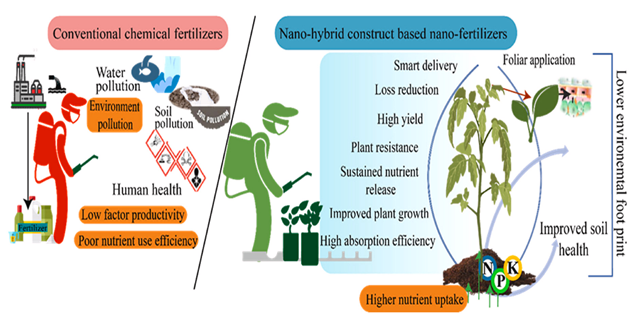
Challenges for Nano Urea:
- A bottle of nano urea is Rs. 10 cheaper than the 45 kg bag of conventional urea that costs Rs. 250. If we include labour cost of spraying then nano-urea costs Rs. 440 per bottle.
- Small and marginal farmers might not be able to adapt to liquid nano fertilisers since spraying equipment is costly and farm holdings are also small.
- For approving any new fertiliser, the Indian Council of Agricultural Research (ICAR) must have data for at least three seasons. Though field trials were undertaken for 94 crops over four seasons, data for three seasons is not available for any single crop.
- Effect of Nano Urea over varied crops in the country is not yet studied.
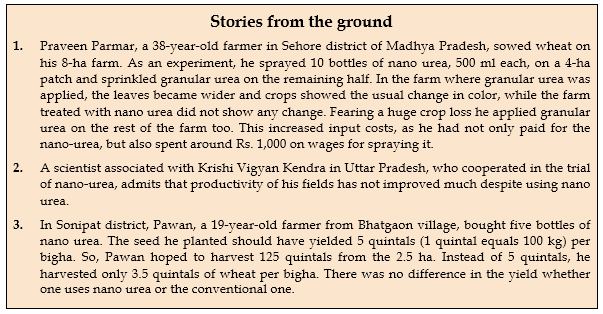
Standing Committee on Nano-Fertilizers for Sustainable Crop Production Recommendations:
- Long term dedicated research should be conducted to assess the benefits and side effects of nano fertilizers.
- Allocate budget and make efforts for providing effective and cheaper means for spraying nano fertilizers.
- The government should devise a plan to conduct regular training programmes for entrepreneurs and farmers about drone-based fertiliser sprayers.
- Committee recommended the Ministry of Finance to bring a production linked incentive (PLI) scheme for nano fertilisers to give a boost to the fertiliser industry.
- Industrial Effluents - Ludhiana Gas Leak
- There was a commotion on the streets of Giaspura, Ludhiana of Punjab. More than 10 people died after leakage of a poisonous gas. The authorities were still trying to find the type of gas that leaked. A civil surgeon in Ludhiana involved in the treatment of victims says that preliminary evidence shows the cause of death was asphyxia (deprivation of oxygen). Post-mortem and clinical features of the survivors suggest that hydrogen sulphide or a combination of gases was responsible.
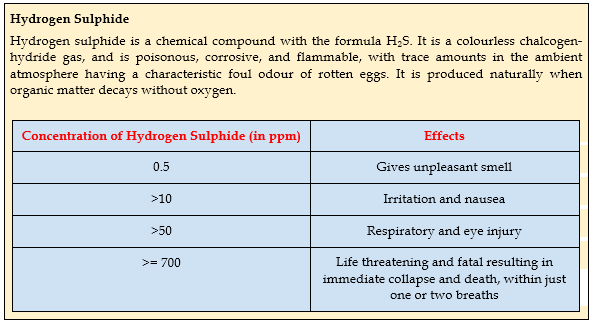
Reasons behind Ludhiana Tragedy:
- Location of factories is in areas like Giaspura, where factories and residences coexist.
- Uncleaned sewers may have caused hydrogen sulphide to build up to deadly levels.
- Possibility of illegal dumping of industrial effluents into the city sewage system.
- Laws and Regulations in place:
- Explosives Act 1884
- Petroleum Act 1934
- Factories Act 1948
- Insecticides Act 1968
- The Water (Prevention & Control of Pollution), Act 1974
- Environment Protection Act 1986
- Motor Vehicles Act 1988
- Public Liability Insurance Act 1991
- Disaster Management Act 2005

Why are Laws Failing?
- Not enough data is collected even though it is prescribed by the existing laws. Eg: 3rd Quarterly Report of the Central Monitoring Committee set up by the National Green Tribunal has both the generation and treatment data for 13 states and Union Territories (UTs), and only generation data for another 10 states and UTs. For six states—Assam, Bihar, Gujarat, Jharkhand, Goa and Manipur—no data is available.
- The information collected is not disseminated regularly and in a timely manner. Enforcing agencies are fighting industrial effluent pollution without even knowing the quantum of the problem
- Regular checks as directed by the laws are not carried out diligently.
- Gross violations can also be seen in the continuous effluent quality monitoring system (CEQMS) used for real-time water pollution monitoring.
- Unavailability of updated tools and devices to measure the effluents and thus remedial actions cannot be taken.
- One of the reasons for the poor compliance could be the fact that pollution control boards remain grossly understaffed. Minister of State for Environment, Forestry and Climate Change, in a reply to a question in the Lok Sabha, admitted that 33 per cent of the 577 sanctioned posts in the cpcb are vacant.

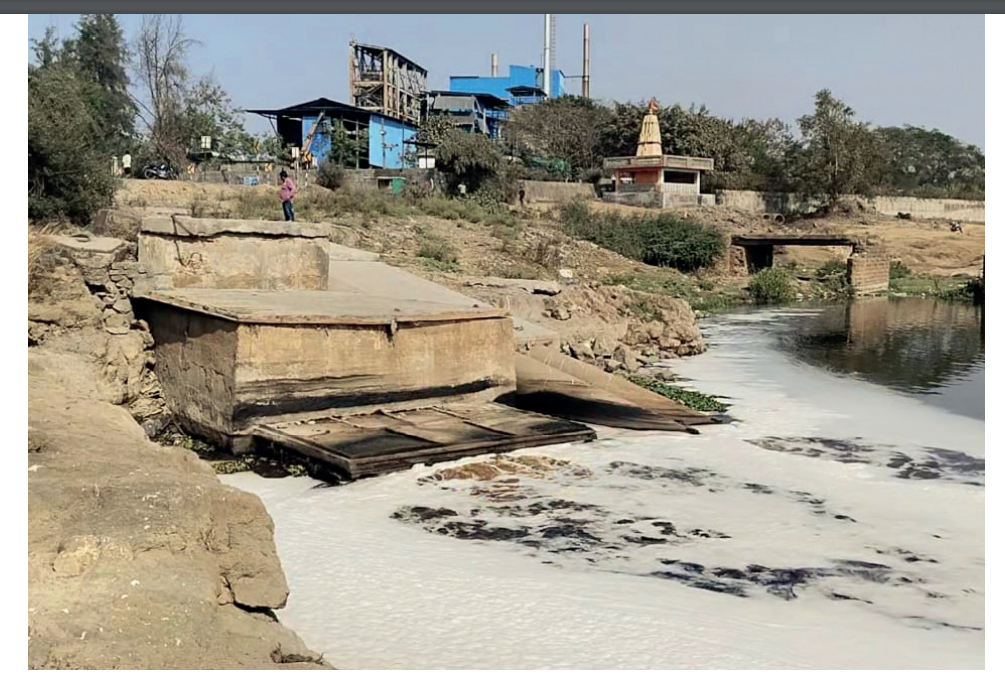
The common effluent treatment plant at Vapi industrial cluster of Valsad district, Gujarat.
Change Required:
- Address Data Vacuum: India needs consolidated figures on effluent generation, treatment and discharge quality. Industries should be graded as per their water consumption and effluent discharge, and then placed on a map to indicate their location.
- Mapping and Planning: All the small- and medium-scale enterprises (SMEs) should be mapped and their location should be planned as per suitability. This would make it easier for monitoring and inspection of SMEs.
- Inclusive Policy Making: Government should take steps to cast a wider net by involving multiple stakeholders like factory owners, local residents, NGOs etc.
- Better Compliance: The 2021 Central Monitoring Committee report observes that 30 percent of the CETPs are non-compliant. This can be checked by regular monitoring and upgradation of CTEPs and effluent pre-treatment facilities.
- World Environment Day - 5 June #OnlyOneEarth
- World Environment Day on 5 June is held annually as one of the biggest international days for the environment led by UNEP. The event has grown to be the largest global platform for environmental outreach, with millions of people from across the world engaging to protect the planet.
- Natural Disaster has been a leading reason for displacement of people around the world. The Internal Displacement Monitoring Centre (IDMC), part of the Norwegian Refugee Council data on disaster and displacement flows (excluding drought) in 2018, shows that some 1.6 million people displaced by disasters were in camps or places away from their homes by the end of that year. By 2021, as many as 30.7 million new displacements occurred due to disasters.
- Global Report on Internal Displacement (GRID) Report 2023
- It is released by IDMC.
- According to the report the displacement figure rose to 32.6 million in 2022. Disaster displacements in 2022 were 40 per cent higher than in 2021.
- Pakistan recorded the highest disaster displacements in the world, 8.16 million, in 2022. It was followed by the Philippines (5.44 million), China (3.63 million), India (2.5 million) and Nigeria(2.4 million).
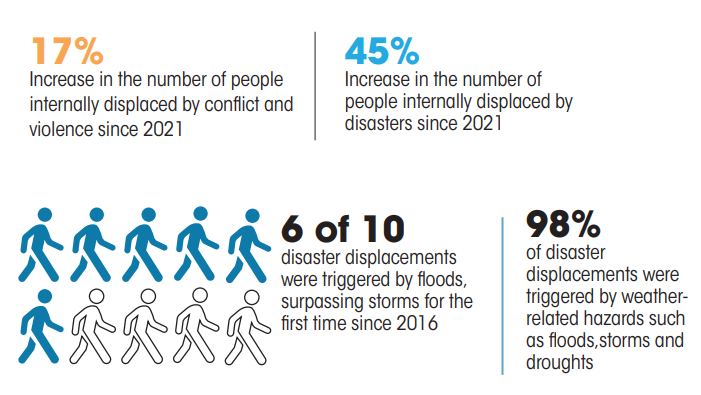
Global Response for Migration:
- USA: The executive order titled, "Rebuilding and Enhancing Programs to Resettle Refugees and Planning for the Impact of Climate Change on Migration" is the first of its kind, in which the US government has linked migration to climate change.
- World Bank: "Groundswell" report, released in September 2021, said that hot spots of internal climate migration can emerge as early as 2030 and continue to spread and intensify by 2050. It attributed climate change to loss of peoples livelihood which in turn triggers migration.
Recommendation of Groundswell Report:
- Reducing global emissions and making every effort to meet the temperature goals of the Paris Agreement.
- Embedding internal climate migration in far-sighted green, resilient, and inclusive development planning.
- Preparing for each phase of migration, so that internal climate migration as an adaptation strategy can result in positive development outcomes.
- Investing in better understanding of the drivers of internal climate migration to inform well-targeted policies.
Mains Questions
- Nano Technology can play a pivotal role in doubling farmers income. Critically analyse the above statement.
- Industrial waste management and disposal remains a problem in India. Suggest some steps to safely and effectively manage industrial waste.
- What are the impediments in disposing of the huge quantities of discarded solid wastes which are continuously being generated? How do we safely remove the toxic wastes that have been accumulating in our habitable environment? (2018)
QUICK LINKS